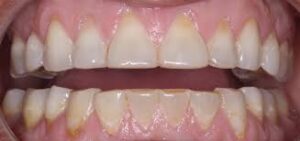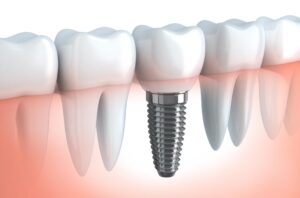Header logo
header top contact widget
Learn More Blog
How Straight Teeth Support Oral Health & Dental Implant Success
Posted on Apr 19, 2021 by William J. Claiborne, DDS MS
As a Periodontist, I often work in conjunction with other dental specialists to provide an optimal outcome at the direction of the patient’s general dentist. By combining our specific skills, we are able to create a complete-care integration of services tailored to attend to unique or complex needs.
For example, as a specialist in the treatment of gum disease and placement of dental implants, my skills are beneficial for ideal outcomes as well as in long-term success. This is especially true when I note signs of bite misalignment in a dental implant patient.
The ‘bite’ refers to how the top row of teeth fit to the bottom row. These upper and lower teeth should “rest” together harmoniously. This fit has a great deal to do with a balanced alignment that is far reaching.
For instance, when teeth are not in proper alignment, there is an interference in the

Teeth worn down from grinding, or “bruxing”
interaction of biting, chewing and even speaking. This misalignment can strain the jaw joints as well as the muscles of the face, extending out to neck and shoulder muscles.
Bite misalignment is a common cause of temporomandibular joint (or TMJ) disorder. The TMJ are located on each side of the head and hinge the lower jaw to the skull. Continual stress on these joints can lead to an inflammation that triggers a series of problems.
In most cases, bite misalignment is what triggers night-time clenching and grinding. Known as bruxing, this action can result in chipped, broken and fractured teeth. Other symptoms associated with a misaligned bite – and thus, TMJ problems – include frequent headaches and migraines, ear ringing, dizziness and difficulty opening the mouth fully.
As an Asheville periodontist, I also see how bite misalignment can cause the gums to recede. This occurs as misaligned teeth tilt or turn, which causes an unnatural pulling on the gum tissues surrounding the tooth at its base. As more vulnerable sections of the tooth are exposed, the risks for developing cavities and gum disease increases.
When it comes to dental implants, success rates can be greatly compromised with the presence of clenching and grinding. Here’s why…
 A dental implant is placed in the jaw bone, serving as a replacement tooth root. During the first 3 – 6 months, the bone grows around it, securing it firmly into the bone surrounding it. This process is known as osseo-integration.
A dental implant is placed in the jaw bone, serving as a replacement tooth root. During the first 3 – 6 months, the bone grows around it, securing it firmly into the bone surrounding it. This process is known as osseo-integration.
It is during this time that an implant is most vulnerable to the forces that clenching and grinding exert. When you consider that implants require up to 6 months to become fully integrated into the bone structure, the stress from grinding or clenching can disrupt this process.
According to an analysis published in Dental Implants (Oct. 2015), and using data from ten publications, bruxers experienced a 6.45 failure rate (as compared to 3.65 in non-bruxers.(https://journals.lww.com/implantdent/fulltext/2015/10000/bruxism_and_dental_implants__a_meta_analysis.5.aspx)
My involvement helps to detect what is not always apparent, yet could have a tremendous impact for a successful outcome. Working to help dental implant patients avoid problems in the future is my goal and helps to protect the patient’s investment.
Certainly, misaligned teeth that are crowded or crooked tend to bunch up together. These teeth often form tight angles, creating hard-to-reach areas that make thorough toothbrushing more difficult. As oral bacteria remain, these areas become breeding grounds for an overload of bacteria that run rampant. This can lead to the formation of cavities and the development of gum disease.
The problem of misalignment can result in a vicious cycle: (1) greater risk for gum disease; (2) higher potential for TMJ disorder; (3) increased risk for tooth loss; (4) more likelihood for dental implant failure.
Consider that periodontal (gum) disease is the nation’s leading cause of adult tooth loss. Thus, a condition such as bruxing, which can lead to gum disease, can increase the potential for tooth loss. And, in replacing teeth, bruxing can continue to compromise tooth replacement success (with dental implants or other means, such as crown-&-bridge).
If you’re considering dental implants but suspect you clench or grind your teeth, we’ll discuss ways you can achieve your smile goals and protect your investment.
Call our Asheville periodontal dental office at 828-274-9440 to schedule a consultation.
Recent Posts
Categories
Archives
- September 2024
- August 2024
- July 2024
- June 2024
- May 2024
- April 2024
- March 2024
- February 2024
- January 2024
- December 2023
- November 2023
- October 2023
- September 2023
- August 2023
- July 2023
- June 2023
- May 2023
- April 2023
- March 2023
- February 2023
- January 2023
- December 2022
- November 2022
- October 2022
- September 2022
- August 2022
- July 2022
- June 2022
- May 2022
- April 2022
- March 2022
- February 2022
- January 2022
- December 2021
- November 2021
- October 2021
- September 2021
- August 2021
- July 2021
- June 2021
- May 2021
- April 2021
- March 2021
- February 2021
- January 2021
- December 2020
- November 2020
- October 2020
- September 2020
- August 2020
- July 2020
- June 2020
- May 2020
- April 2020
- March 2020
- February 2020
- January 2020
- December 2019
- November 2019
- October 2019
- September 2019
- August 2019
- July 2019
- June 2019
- May 2019
- April 2019
- March 2019
- February 2019
- January 2019
- December 2018
- November 2018
- October 2018
- September 2018
- August 2018
- July 2018
- June 2018
- May 2018
- April 2018
- March 2018
- February 2018
- January 2018
- December 2017
- November 2017
- October 2017
- September 2017
- August 2017
- July 2017
- June 2017
- May 2017
- April 2017
- March 2017
- February 2017
- January 2017
- December 2016
- November 2016
- October 2016
- September 2016
- August 2016
- July 2016
- June 2016
- May 2016
- April 2016
- March 2016
- February 2016
- January 2016
- December 2015
- November 2015
- October 2015
- September 2015
- August 2015
- July 2015
- June 2015
- May 2015
- April 2015
- March 2015
- February 2015
- January 2015
- December 2014
- November 2014
- October 2014
- September 2014
- August 2014
- July 2014
- June 2014
- May 2014
- April 2014
- March 2014
- February 2014
- January 2014
- December 2013
- November 2013
- October 2013
- September 2013
- August 2013
- July 2013
- June 2013
- May 2013
- April 2013
- March 2013
- February 2013
- January 2013
- December 2012
- November 2012
- October 2012
- September 2012
- August 2012
- July 2012
- June 2012

